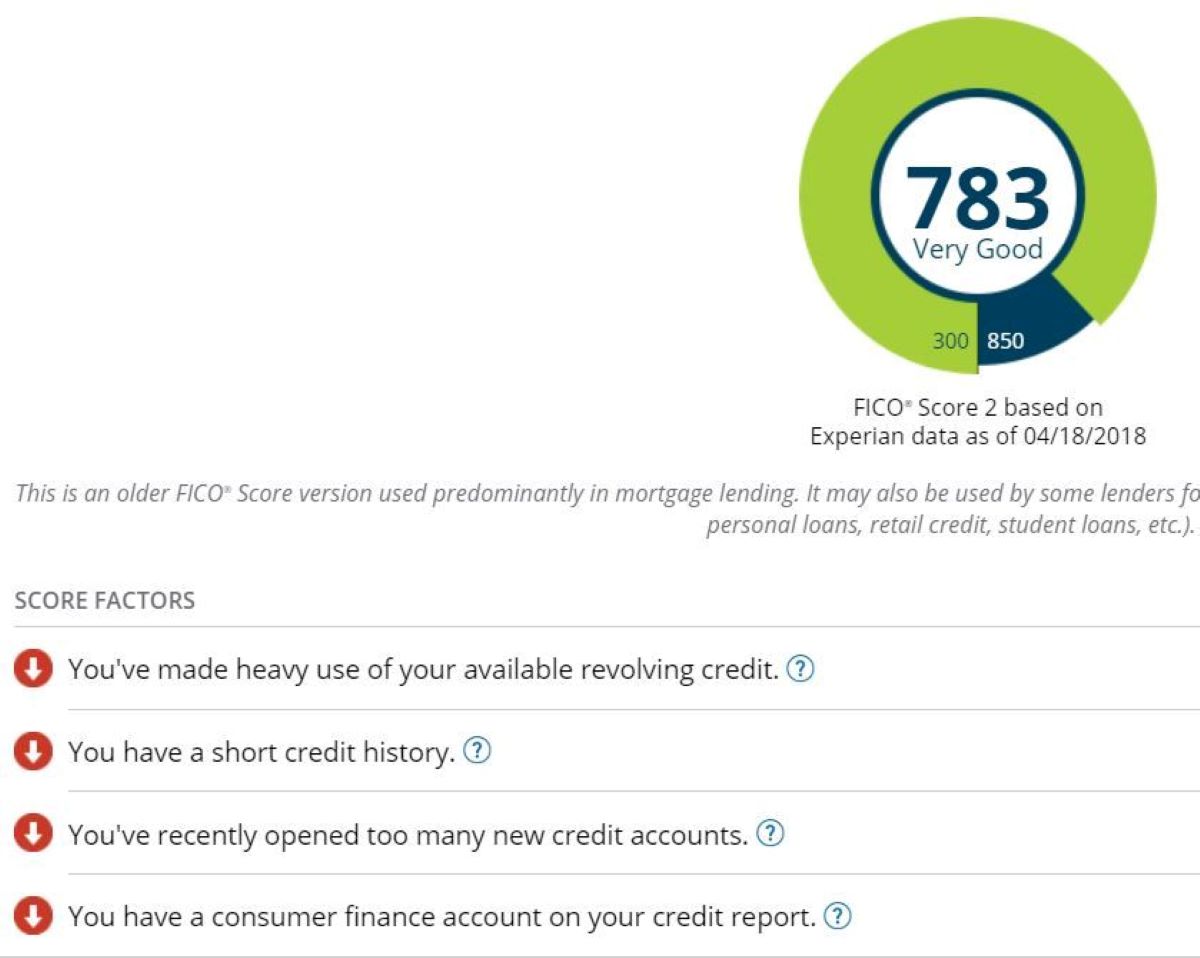

Finance
Why Does My Available Credit Say 0
Modified: March 5, 2024
Find out why your available credit says 0. Understand the key finance factors affecting your credit availability and learn how to improve it.
(Many of the links in this article redirect to a specific reviewed product. Your purchase of these products through affiliate links helps to generate commission for LiveWell, at no extra cost. Learn more)
Table of Contents
- Introduction
- Definition of Available Credit
- Factors that can Cause Available Credit to Show as 0
- Insufficient Credit Limit
- Maximum Credit Utilization
- High Outstanding Balances
- Recent Credit Limit Decrease
- Reporting Delays
- Identity Theft or Fraudulent Activity
- Credit Bureau Errors
- How to Fix the Issue of Available Credit Showing as 0
- Contacting the Credit Card Issuer
- Paying Off Outstanding Balances
- Requesting a Credit Limit Increase
- Monitoring Credit Reports and Scores
- Conclusion
Introduction
Understanding your available credit is essential for managing your finances wisely. It allows you to gauge how much credit you have at your disposal and plays a crucial role in your credit utilization ratio. However, it can be concerning when you check your account and find that your available credit is showing as 0. This discrepancy can leave you wondering what went wrong and how it can be rectified.
Having a credit limit is the maximum amount of money that a credit card issuer is willing to lend you. Available credit, on the other hand, is the amount of credit that remains unused and is available for you to spend.
When your available credit shows as 0, it essentially means that your credit card is maxed out or you no longer have any remaining credit to utilize.
There are various factors that can cause your available credit to show as 0. It could be due to an insufficient credit limit, high outstanding balances, a recent credit limit decrease, reporting delays, identity theft or fraudulent activity, or even credit bureau errors.
In this article, we will explore each of these factors in detail and provide insights on how to fix the issue of available credit showing as 0.
Definition of Available Credit
Available credit refers to the portion of your credit limit that is currently unused and available for you to use. It represents the amount of credit that you have at your disposal for making purchases, taking out loans, or accessing funds from credit accounts, such as credit cards or lines of credit.
When you are approved for a credit card or a line of credit, the lender assigns you a credit limit. This credit limit serves as the maximum amount that you can borrow or charge to your account. The available credit, therefore, represents the difference between your credit limit and your current outstanding balances.
For example, if you have a credit card with a credit limit of $5,000 and you have a balance of $1,000, your available credit would be $4,000. This means that you still have $4,000 of credit that you can utilize before reaching your credit limit.
Monitoring your available credit is essential for maintaining a healthy credit profile. Lenders and credit bureaus use this information to assess your creditworthiness and determine your credit utilization ratio. Your credit utilization ratio is calculated by dividing your total outstanding balances by your total credit limit. A lower credit utilization ratio is generally seen as favorable and can positively impact your credit score.
It is important to note that available credit is not a permanent figure. It fluctuates as you make purchases, payments, and as your credit card issuer reports updates to the credit bureaus. Your available credit may decrease when you make new charges or increase when you make payments to reduce your balances.
Hence, it is crucial to keep track of your available credit and ensure that it remains at a comfortable level to avoid maxing out your credit cards and potentially harming your credit score.
Factors that can Cause Available Credit to Show as 0
There are several factors that can cause your available credit to show as 0. Understanding these factors can help you identify the root cause of the issue and take appropriate steps to address it. Here are some common reasons why your available credit may be displaying as 0:
- Insufficient Credit Limit: One of the most straightforward reasons is that your credit limit is too low to support any available credit. If your credit card issuer has set a limit that is equal to or below your outstanding balance, your available credit will show as 0.
- Maximum Credit Utilization: If you have utilized a significant portion of your credit limit, your credit card issuer may consider your available credit as 0. Lenders typically prefer to see a lower credit utilization ratio, ideally below 30%, to ensure responsible credit usage.
- High Outstanding Balances: When you carry high balances on your credit cards, it reduces the amount of available credit you have. If your balances are close to or equal to your credit limit, your available credit will appear as 0 until you make payments to reduce your outstanding balances.
- Recent Credit Limit Decrease: Sometimes, credit card issuers may decide to reduce your credit limit. This can occur due to various reasons, such as changes in your credit score, delinquencies, or changes in your financial situation. If your credit limit is lowered and your outstanding balances remain the same, it can result in your available credit showing as 0.
- Reporting Delays: The timing of when your credit card issuer reports your account information to the credit bureaus can impact your available credit. If you made a payment or reduced your balances recently, but the update hasn’t been reflected in your credit report, it may temporarily display as 0 available credit.
- Identity Theft or Fraudulent Activity: If you suspect any unauthorized charges or fraudulent activity on your account, your credit card issuer may freeze your available credit to prevent further unauthorized transactions. This is done in order to protect your account and mitigate potential financial losses.
- Credit Bureau Errors: Credit reporting errors can occur and impact your available credit. It’s essential to regularly monitor your credit reports for inaccuracies or discrepancies that could affect your available credit. If you spot any errors, you should promptly dispute them with the credit bureaus to have them corrected.
Understanding the factors that can cause your available credit to show as 0 can help you address the issue more effectively. By identifying the specific reason behind this discrepancy, you can take the necessary steps to rectify the situation and ensure that your credit utilization remains in a healthy range.
Insufficient Credit Limit
One reason why your available credit may show as 0 is if your credit limit is too low to support any remaining credit. When you initially apply for a credit card or a loan, the lender reviews your credit history, income, and other factors to determine the appropriate credit limit for your account.
If your credit limit is set at an amount that is equal to or below your outstanding balance, your available credit will show as 0. This means that you have utilized your entire credit limit, leaving no room for any additional credit to be available for use.
To address this issue, you can contact your credit card issuer or lender and request a credit limit increase. A higher credit limit can provide you with more available credit and potentially improve your credit utilization ratio, which may positively impact your credit score.
Before requesting a credit limit increase, it’s important to assess your financial situation and determine if you can handle the responsibility of having a higher credit limit. Increased credit limit should not be viewed as an opportunity to accumulate more debt, but rather as a tool to manage your finances more effectively.
You can demonstrate your creditworthiness to the credit card issuer by making consistent, on-time payments, maintaining a low credit utilization ratio, and having a positive credit history. However, keep in mind that the credit card issuer has the discretion to approve or deny any credit limit increase requests based on their assessment of your financial situation.
If a credit limit increase is not immediately granted, you can explore other options to manage your available credit. One option is to make payments to reduce your outstanding balances and free up some available credit. By paying down your balances, you decrease the amount of credit utilized and increase your available credit, even without a higher credit limit.
Remember, it’s crucial to use credit responsibly and to only charge what you can afford to repay. Keeping your credit utilization ratio low and maintaining a healthy credit profile can not only improve your chances of being approved for future credit limit increases but also provide you with more financial flexibility and peace of mind.
Maximum Credit Utilization
One factor that can cause your available credit to show as 0 is reaching the maximum credit utilization limit. Credit utilization refers to the amount of credit that you have utilized compared to your total available credit limit.
Lenders and credit bureaus consider credit utilization as a significant factor when assessing your creditworthiness. Keeping your credit utilization ratio low is typically seen as a positive indicator of responsible credit management. As a general rule of thumb, it is recommended to keep your credit utilization ratio below 30%.
If you have reached or exceeded this threshold, your available credit may appear as 0. This means you have utilized a significant portion of your credit limit, leaving no room for additional credit to be utilized.
To address this issue and increase your available credit, there are a few steps you can take:
- Pay down balances: Making extra payments or paying more than the minimum payment due can help reduce your outstanding balances. By doing so, you decrease your credit utilization ratio and increase your available credit.
- Spread purchases across different cards: If you have multiple credit cards, consider distributing your purchases across different cards to keep your credit utilization ratio low on each card. This can help prevent maxing out a single card and potentially impacting your available credit.
- Request a credit limit increase: Contact your credit card issuer and request a credit limit increase. A higher credit limit can lower your credit utilization ratio and increase your available credit. However, be cautious when requesting a credit limit increase, as it may result in a hard inquiry on your credit report which can temporarily impact your credit score.
- Consider debt consolidation: If you have multiple credit card balances, consolidating them into a single loan with a fixed interest rate may help you manage your debt more effectively. This can potentially lower your overall credit utilization and improve your available credit.
It is important to note that focusing solely on maintaining a low credit utilization ratio should not overshadow other important factors affecting your creditworthiness. Payment history, length of credit history, types of credit used, and new credit applications are also crucial aspects to consider when managing your overall credit health.
By actively managing your credit utilization, paying down balances, and being mindful of your spending habits, you can maintain a healthy credit profile and ensure that your available credit remains sufficient for your financial needs.
High Outstanding Balances
Having high outstanding balances on your credit cards can significantly impact your available credit and cause it to show as 0. When you carry balances that are close to or equal to your credit limit, it leaves little or no remaining credit available for you to use.
If you consistently make large purchases or carry high balances from month to month, your available credit may be limited. This can make it difficult to access additional credit until you make payments to reduce your outstanding balances.
To address this issue and increase your available credit, there are several steps you can take:
- Pay down your balances: Making consistent and larger payments towards your outstanding balances can help reduce them more quickly. By decreasing your balances, you increase your available credit and improve your credit utilization ratio.
- Create a repayment plan: Develop a strategy to systematically pay off your outstanding balances. Consider prioritizing higher interest rate debts or utilizing the debt avalanche or debt snowball method to tackle your balances more efficiently.
- Reduce discretionary spending: Temporarily limit your discretionary expenses to free up more funds to put towards paying down your balances. Cutting back on non-essential purchases can help expedite the process of reducing your outstanding balances and increasing your available credit.
- Explore balance transfer options: Consider transferring high-interest credit card balances to a card with a lower interest rate or a promotional 0% APR period. This can help you save on interest charges and make it easier to pay down your balances.
Keep in mind that reducing high outstanding balances takes time and discipline. It’s important to develop healthy financial habits and avoid excessive spending to prevent falling back into a cycle of carrying high balances.
In addition to paying down balances, it’s also crucial to avoid accumulating new debt. Be mindful of your spending habits and limit your credit card usage to essential purchases only. By managing your credit responsibly, you can maintain a healthy credit profile, increase your available credit, and improve your overall financial well-being.
Recent Credit Limit Decrease
A recent credit limit decrease can be a reason why your available credit is showing as 0. Credit card issuers have the authority to lower your credit limit based on various factors, such as changes in your creditworthiness, account activity, or the card issuer’s internal policies.
When your credit limit is reduced and your outstanding balances remain the same, it can result in your available credit appearing as 0. This reduction in credit limit can be disruptive to your financial plans and may make it challenging to access additional credit.
If you discover that your credit limit has been lowered, there are a few steps you can take to address the issue:
- Contact your credit card issuer: Reach out to your credit card issuer to understand the reason behind the credit limit decrease. Inquire about any specific actions you can take to restore or increase your credit limit.
- Discuss your financial situation: Explain your financial circumstances to the credit card issuer if you have experienced a temporary setback or unexpected financial stress. Demonstrating responsible payment behavior and a stable income may help in regaining a higher credit limit.
- Request a credit limit increase: While your recent credit limit decrease may make it challenging to obtain an immediate credit limit increase, you can inquire about the possibility of a future increase. Focus on improving your creditworthiness and maintaining healthy financial habits to strengthen your chances of a credit limit increase in the future.
- Pay down outstanding balances: Making efforts to pay down your balances can improve your available credit even with a lower credit limit. By reducing your outstanding balances, you decrease your credit utilization ratio and increase the amount of available credit.
It’s important to note that credit card issuers have the discretion to reduce credit limits based on their assessment of your creditworthiness and overall risk. To prevent future credit limit decreases, make sure to manage your credit responsibly by making timely payments, keeping your credit utilization low, and demonstrating overall financial stability.
Regularly monitoring your credit reports and scores can also help you stay aware of any changes to your credit limits and take early action if needed. By staying proactive, you can minimize the impact of a credit limit decrease and work towards rebuilding your available credit over time.
Reporting Delays
Reporting delays in updating your account information with the credit bureaus can sometimes cause your available credit to show as 0. Credit card issuers typically report your account status and credit utilization to the credit bureaus once a month, but the timing can vary.
If you have made recent payments or reduced your outstanding balances, but the credit card issuer has not yet reported these updates, your available credit may temporarily display as 0 until the information is updated in your credit report.
In such cases, there are a few steps you can take to address the issue:
- Monitor your credit reports regularly: Keep track of your credit reports from the major credit bureaus – Equifax, Experian, and TransUnion. Regularly review your reports to ensure that the information is accurate and up to date.
- Contact your credit card issuer: Reach out to your credit card issuer to confirm when they typically report account updates to the credit bureaus. This way, you can have a better understanding of when to expect your updated available credit to reflect in your credit report.
- Consider timing of payments: If you want your available credit to be updated sooner, you may opt to make payments a few days before the credit card issuer’s reporting date. This increases the likelihood that your payment will be reflected in the next reporting cycle.
- Be patient: It’s important to remember that reporting delays are common, and credit card issuers have their own reporting schedules. Sometimes, it may take a few weeks for your updated available credit to be accurately reflected in your credit report.
While reporting delays can temporarily affect the visibility of your available credit, it is important to continue practicing good credit habits, such as making timely payments and keeping your credit utilization low. Over time, as the updated information is reflected in your credit report, your available credit will accurately reflect any recent changes.
By maintaining consistent and responsible credit behavior, you can ensure that your available credit remains at a comfortable level and support your overall financial goals.
Identity Theft or Fraudulent Activity
Identity theft and fraudulent activity can be a cause for your available credit to show as 0. If you suspect any unauthorized charges or fraudulent transactions on your credit card, your credit card issuer may take immediate action to protect your account, including freezing your available credit.
When your credit card issuer detects suspicious activity, they may temporarily restrict your available credit to prevent further unauthorized transactions. This is done to safeguard your account and mitigate potential financial losses.
If you suspect that your available credit is showing as 0 due to identity theft or fraudulent activity, here are the steps to address the issue:
- Contact your credit card issuer: Immediately notify your credit card issuer about the suspected fraudulent activity. They will guide you through the process of addressing the issue and take necessary actions to secure your account.
- Dispute unauthorized charges: If you notice any unauthorized charges on your credit card statement, dispute them with your credit card issuer. They will investigate the charges and work with you to resolve the issue.
- Place a fraud alert or credit freeze: Consider placing a fraud alert or credit freeze with the credit bureaus to protect your credit. A fraud alert notifies potential creditors to take additional steps to verify your identity before approving new credit applications. A credit freeze restricts access to your credit report, preventing new credit accounts from being opened without your approval.
- Monitor your accounts: Regularly monitor your credit card and bank accounts for any suspicious activity. Report any unrecognized charges or transactions promptly to the respective financial institution.
It’s crucial to take immediate action when you suspect identity theft or fraudulent activity to minimize any potential damage to your credit and finances. By working closely with your credit card issuer and taking the necessary precautions, you can address the issue and restore your available credit.
Remember to review your credit reports regularly and consider using credit monitoring services to stay alerted to any unusual activity. Taking proactive steps to protect your identity and financial information is essential in maintaining the security of your available credit and overall financial well-being.
Credit Bureau Errors
Credit bureau errors can be another factor that causes your available credit to show as 0. Mistakes and inaccuracies on your credit report can occur due to various reasons, such as clerical errors, data entry mistakes, or incomplete information from lenders or creditors.
If there are errors in your credit report that incorrectly reflect your credit utilization or outstanding balances, it can impact the calculation of your available credit. This discrepancy can lead to a misrepresentation of your available credit and negatively affect your creditworthiness.
To address credit bureau errors and resolve the issue of your available credit showing as 0, follow these steps:
- Obtain a copy of your credit report: Request a copy of your credit report from each of the major credit bureaus – Equifax, Experian, and TransUnion. Review your credit reports carefully, paying close attention to any errors or inaccuracies related to your available credit.
- Dispute the errors: If you identify any errors, file a dispute with the credit bureaus to have them corrected. Provide supporting documentation, such as credit card statements or payment records, to substantiate your claim. The credit bureaus are required by law to investigate and correct any inaccurate information within a certain timeframe.
- Follow up on the resolution: Stay diligent and follow up with the credit bureaus to ensure that the errors are rectified. Monitor your credit reports regularly to verify that the corrections have been made and that your available credit is accurately represented.
- Notify your credit card issuer: If the error in your available credit is due to incorrect reporting by your credit card issuer, inform them about the discrepancy. Provide them with the necessary information and documentation to support the correction of the reporting error.
It’s important to note that the process of correcting credit bureau errors can take time. However, staying proactive, providing accurate documentation, and monitoring the progress of your dispute can help expedite the resolution.
Regularly reviewing your credit reports and addressing any inaccuracies promptly is important to ensure that your available credit and overall creditworthiness are represented correctly. By maintaining accurate credit reports, you can have a clear understanding of your available credit and make informed financial decisions.
How to Fix the Issue of Available Credit Showing as 0
Discovering that your available credit is showing as 0 can be concerning, but there are steps you can take to address and resolve the issue. Here are some strategies to fix the issue of 0 available credit:
- Contacting the Credit Card Issuer: Start by contacting your credit card issuer or lender to inquire about the reason behind your available credit showing as 0. They can provide information specific to your account and guide you through the necessary steps to rectify the situation.
- Paying Off Outstanding Balances: If high outstanding balances are the cause of your available credit showing as 0, focus on paying down your balances. Making extra payments or increasing your monthly payments can help reduce your outstanding balances and increase your available credit.
- Requesting a Credit Limit Increase: If you have a good payment history and demonstrate responsible credit usage, you can consider requesting a credit limit increase from your credit card issuer. A higher credit limit can provide you with more available credit and improve your credit utilization ratio.
- Monitoring Credit Reports and Scores: Regularly monitoring your credit reports and credit scores is crucial. Keep track of any changes, errors, or discrepancies that may impact your available credit. By staying informed, you can address issues promptly and ensure the accuracy of your credit information.
When addressing the issue of 0 available credit, it’s essential to take proactive steps to improve your credit management habits. This includes making payments on time, keeping your credit utilization ratio low, and avoiding excessive or unnecessary credit card usage.
Remember, managing your available credit responsibly is key to maintaining a healthy credit profile. By staying diligent, addressing the underlying causes, and taking appropriate actions, you can improve your available credit and ensure that it accurately reflects your creditworthiness.
Contacting the Credit Card Issuer
If you discover that your available credit is showing as 0, one of the first steps to take is to contact your credit card issuer or lender. They will have the necessary information about your account and can help provide insights into why your available credit is displaying as 0. Here’s what you should consider when reaching out to your credit card issuer:
- Speak to the customer service department: Contact the customer service department of your credit card issuer. The phone number is typically found on the back of your credit card or on the monthly statements. Explain the situation and express your concern about your available credit showing as 0.
- Verify your account information: Provide your account details, such as your credit card number, name, and any other relevant information, to help the customer service representative locate your account and access the necessary details.
- Ask for an explanation: Inquire about the reason behind your available credit showing as 0. It could be due to factors such as a low credit limit, high outstanding balances, or a recent credit limit decrease. Understanding the cause will help you address the issue effectively.
- Seek clarification on credit reporting processes: Ask about the frequency and timing of when your credit card issuer reports your account information to the credit bureaus. Request information about any recent reporting updates or delay that might affect the visibility of your available credit.
- Discuss potential solutions: Based on the information provided by the customer service representative, explore potential solutions to address the issue. This may involve making payments to reduce outstanding balances, requesting a credit limit increase, or addressing any errors or discrepancies in your account.
- Keep records of communication: It’s important to document all communication with your credit card issuer, including the date, time, name of the representative, and any reference numbers provided. These records can serve as valuable documentation in case of any disputes or follow-up actions.
Remember to remain calm and polite during the conversation with the credit card issuer. Maintaining a positive and respectful attitude will help ensure a productive discussion and increase the chances of finding a satisfactory resolution to the issue.
By reaching out to your credit card issuer, you can gain insights into the specific reasons behind your available credit showing as 0 and work together to find the most appropriate solution for your situation.
Paying Off Outstanding Balances
If your available credit is showing as 0, one of the key steps to rectify the issue is to focus on paying off your outstanding balances. High balances can limit your available credit and impact your credit utilization ratio. Here’s how you can effectively tackle outstanding balances:
- Create a repayment plan: Assess your outstanding balances and create a repayment plan. Determine how much you can allocate towards debt repayment each month and prioritize paying off high-interest accounts or those with the smallest balances (debt snowball method) to build momentum.
- Review your budget: Take a close look at your budget and identify areas where you can cut back on expenses to free up additional funds for debt repayment. Consider eliminating non-essential spending and redirecting those funds towards paying off your balances.
- Pay more than the minimum: While making minimum payments is necessary to stay current, it’s advisable to pay more than the minimum amount due whenever possible. By paying more, you can reduce the principal balance faster, saving money on interest charges, and accelerating the payoff process.
- Consider a debt consolidation strategy: Explore debt consolidation options if you have multiple outstanding balances across different accounts. Consolidating your debts into a single account or securing a balance transfer to a low-interest or 0% APR card can simplify your payments and potentially save you money on interest.
- Use windfalls or additional income: If you receive any unexpected windfalls, such as a tax refund or work bonus, consider allocating a portion or all of it towards paying down your balances. Similarly, any additional income or extra money you receive can be used to make larger payments and accelerate debt repayment.
Committing to paying off your outstanding balances requires discipline and persistence. Consistently making payments and reducing your balances will gradually increase your available credit. Alongside paying off your balances, it’s crucial to avoid accumulating new debt and practice responsible credit card usage.
Remember, paying off outstanding balances not only increases your available credit but also helps improve your overall financial health by reducing interest costs, boosting your credit score, and providing you with a sense of financial freedom.
Requesting a Credit Limit Increase
If your available credit is showing as 0, one option to consider is requesting a credit limit increase from your credit card issuer. By increasing your credit limit, you can expand your available credit and potentially improve your credit utilization ratio. Here’s how you can go about requesting a credit limit increase:
- Review your payment history: Before requesting a credit limit increase, assess your payment history. Lenders typically prefer to see a consistent record of on-time payments. If you have a history of late or missed payments, focus on improving your payment behavior before making the request.
- Contact your credit card issuer: Reach out to your credit card issuer’s customer service department to inquire about the process for requesting a credit limit increase. They will provide you with the necessary information and guidelines to proceed with the request.
- Explain your request: While contacting your credit card issuer, explain why you are requesting a credit limit increase. You can mention factors such as an improved credit score, increased income, or a need for more available credit to manage your expenses effectively.
- Provide supporting information: In some cases, your credit card issuer may ask for additional documentation to support your request. This can include recent pay stubs or tax returns to verify your income, or a copy of your credit report to demonstrate your creditworthiness.
- Consider timing: Determine the right time to request a credit limit increase. If you have recently received a raise or improved your credit score, it might be an opportune moment to increase your chances of approval. Timing your request strategically can enhance the likelihood of a positive outcome.
- Be prepared for a credit inquiry: Keep in mind that requesting a credit limit increase may result in a hard inquiry on your credit report. This can have a minor and temporary impact on your credit score. If you have concerns about potential credit score implications, discuss this with your credit card issuer before proceeding.
While a credit limit increase can provide you with more available credit, it’s essential to exercise caution and use it responsibly. A higher credit limit should not be seen as an opportunity to accumulate more debt but rather as a tool to manage your finances effectively.
Remember, credit card issuers have the discretion to approve or deny credit limit increase requests based on their assessment of your creditworthiness. If your request is denied, don’t be discouraged. Continue practicing responsible credit habits, such as making timely payments and managing your credit utilization, to improve your chances of obtaining a higher credit limit in the future.
Requesting a credit limit increase, if approved, can help increase your available credit and provide you with more financial flexibility. However, make sure to consider your individual financial situation and use the increased credit limit wisely.
Monitoring Credit Reports and Scores
When your available credit shows as 0, it’s crucial to regularly monitor your credit reports and scores. Monitoring your credit enables you to stay aware of any changes, inaccuracies, or discrepancies that may affect your available credit. Here’s how you can effectively monitor your credit:
- Obtain your credit reports: Request a free copy of your credit report from each of the major credit bureaus – Equifax, Experian, and TransUnion. Review the reports to check for any errors, outdated information, or signs of fraudulent activity.
- Check your credit scores: Access your credit scores through various credit monitoring services or directly from the credit bureaus. Keep track of any fluctuations or changes in your scores, as they can provide insight into your credit health and potential impacts on your available credit.
- Review personal and account information: Ensure that your personal information, such as your name, address, and Social Security number, is accurate on your credit reports. Additionally, review your account information to confirm that your credit limits and balances are correctly reported.
- Dispute errors or discrepancies: If you discover any errors or discrepancies on your credit reports that are impacting your available credit, file a dispute with the credit bureaus. Provide supporting documentation to substantiate your claim and request corrections.
- Set up credit monitoring alerts: Take advantage of credit monitoring services that offer alerts for changes in your credit reports or scores. These alerts can notify you of significant changes, such as new accounts opened in your name or unexpected drops in your credit scores.
- Monitor for signs of identity theft: Keep a vigilant eye out for any signs of identity theft, such as unauthorized accounts or suspicious inquiries. Report any suspicious activity to the credit bureaus and take immediate action to mitigate potential damages.
Regularly monitoring your credit reports and scores allows you to address any issues affecting your available credit promptly. By identifying errors or discrepancies early on, you can work towards resolving them and ensuring your credit information is up to date and accurate.
Remember, monitoring your credit is an ongoing process. Aim to review your credit reports at least once a year and consider utilizing credit monitoring services for more frequent updates. Being proactive and staying informed about your credit health can help you maintain a good credit profile and ensure that your available credit is accurately represented.
Conclusion
Discovering that your available credit is showing as 0 can be a concerning situation, but understanding the underlying factors and taking appropriate steps can help resolve the issue. From addressing insufficient credit limits to managing high outstanding balances, there are several strategies you can implement to rectify the problem.
In some cases, contacting your credit card issuer to discuss the issue and request a credit limit increase may be the solution. Paying off outstanding balances, monitoring your credit reports and scores, and addressing any errors or discrepancies are also crucial steps in improving your available credit.
It’s important to remember that managing your available credit is an integral part of maintaining a healthy credit profile. Through responsible credit usage, timely payments, and a proactive approach to monitoring your credit, you can ensure that your available credit remains sufficient for your financial needs.
Furthermore, staying vigilant and promptly addressing any potential issues such as identity theft or credit bureau errors can help safeguard your credit and protect you from unnecessary hurdles in accessing credit.
By taking the necessary steps outlined in this article, you can work towards increasing your available credit, improving your credit utilization ratio, and maintaining a positive credit standing. Remember to review your credit reports regularly, monitor your credit scores, and make informed financial decisions based on your individual circumstances.
Ultimately, by demonstrating responsible credit behavior and actively managing your finances, you can enhance your financial well-being, achieve your financial goals, and ensure that your available credit accurately reflects your creditworthiness.














